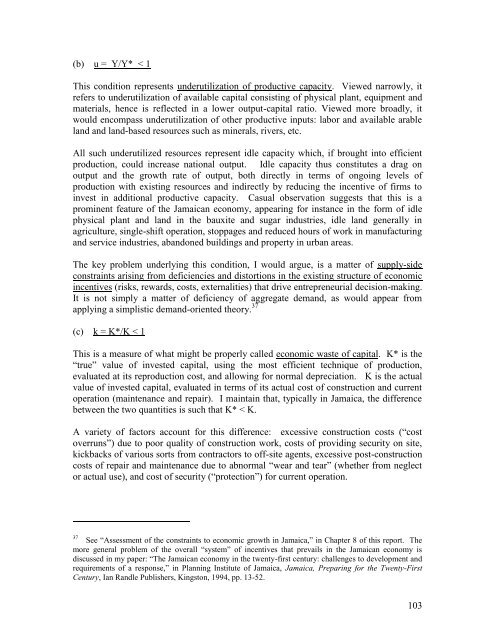PIOJ Growth-Inducement Strategy - Planning Institute of Jamaica
PIOJ Growth-Inducement Strategy - Planning Institute of Jamaica
PIOJ Growth-Inducement Strategy - Planning Institute of Jamaica
Create successful ePaper yourself
Turn your PDF publications into a flip-book with our unique Google optimized e-Paper software.
(b) u = Y/Y* < 1<br />
This condition represents underutilization <strong>of</strong> productive capacity. Viewed narrowly, it<br />
refers to underutilization <strong>of</strong> available capital consisting <strong>of</strong> physical plant, equipment and<br />
materials, hence is reflected in a lower output-capital ratio. Viewed more broadly, it<br />
would encompass underutilization <strong>of</strong> other productive inputs: labor and available arable<br />
land and land-based resources such as minerals, rivers, etc.<br />
All such underutilized resources represent idle capacity which, if brought into efficient<br />
production, could increase national output. Idle capacity thus constitutes a drag on<br />
output and the growth rate <strong>of</strong> output, both directly in terms <strong>of</strong> ongoing levels <strong>of</strong><br />
production with existing resources and indirectly by reducing the incentive <strong>of</strong> firms to<br />
invest in additional productive capacity. Casual observation suggests that this is a<br />
prominent feature <strong>of</strong> the <strong>Jamaica</strong>n economy, appearing for instance in the form <strong>of</strong> idle<br />
physical plant and land in the bauxite and sugar industries, idle land generally in<br />
agriculture, single-shift operation, stoppages and reduced hours <strong>of</strong> work in manufacturing<br />
and service industries, abandoned buildings and property in urban areas.<br />
The key problem underlying this condition, I would argue, is a matter <strong>of</strong> supply-side<br />
constraints arising from deficiencies and distortions in the existing structure <strong>of</strong> economic<br />
incentives (risks, rewards, costs, externalities) that drive entrepreneurial decision-making.<br />
It is not simply a matter <strong>of</strong> deficiency <strong>of</strong> aggregate demand, as would appear from<br />
applying a simplistic demand-oriented theory. 37<br />
(c) k = K*/K < 1<br />
This is a measure <strong>of</strong> what might be properly called economic waste <strong>of</strong> capital. K* is the<br />
“true” value <strong>of</strong> invested capital, using the most efficient technique <strong>of</strong> production,<br />
evaluated at its reproduction cost, and allowing for normal depreciation. K is the actual<br />
value <strong>of</strong> invested capital, evaluated in terms <strong>of</strong> its actual cost <strong>of</strong> construction and current<br />
operation (maintenance and repair). I maintain that, typically in <strong>Jamaica</strong>, the difference<br />
between the two quantities is such that K* < K.<br />
A variety <strong>of</strong> factors account for this difference: excessive construction costs (“cost<br />
overruns”) due to poor quality <strong>of</strong> construction work, costs <strong>of</strong> providing security on site,<br />
kickbacks <strong>of</strong> various sorts from contractors to <strong>of</strong>f-site agents, excessive post-construction<br />
costs <strong>of</strong> repair and maintenance due to abnormal “wear and tear” (whether from neglect<br />
or actual use), and cost <strong>of</strong> security (“protection”) for current operation.<br />
37<br />
See “Assessment <strong>of</strong> the constraints to economic growth in <strong>Jamaica</strong>,” in Chapter 8 <strong>of</strong> this report. The<br />
more general problem <strong>of</strong> the overall “system” <strong>of</strong> incentives that prevails in the <strong>Jamaica</strong>n economy is<br />
discussed in my paper: “The <strong>Jamaica</strong>n economy in the twenty-first century: challenges to development and<br />
requirements <strong>of</strong> a response,” in <strong>Planning</strong> <strong>Institute</strong> <strong>of</strong> <strong>Jamaica</strong>, <strong>Jamaica</strong>, Preparing for the Twenty-First<br />
Century, Ian Randle Publishers, Kingston, 1994, pp. 13-52.<br />
103
















